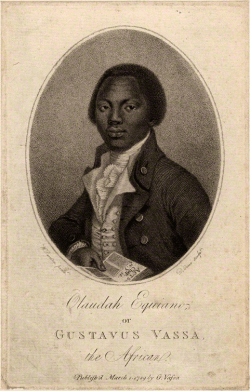Author and abolitionist Olaudah Equiano was, according to his own account, born in Africa, probably in southern Nigeria, in 1745.
Equiano, whose claim to have been born in Africa has recently been the subject of some dispute, wrote that he was kidnapped from his home as an 11-year-old child and sold to slave traders. He was sold again several times and eventually put on a slave ship to Barbados in the British West Indies before being sent on to the Colony of Virginia in what is now the US.

There he was purchased by Michael Henry Pascal, a lieutenant in the Royal Navy, who, against Equiano’s wishes, renamed him ‘Gustavus Vassa’ after 16th-century King of Sweden (he had previously been given names Michael and Jacob).
Equiano accompanied Pascal back to England then served as his valet during the Seven Years’ War with France, a role which saw present at or participating in several battles.
He learnt to read and write during this period and was baptised as a Christian in St Margaret’s Church in Westminster on 9th February, 1759.
In December, 1762, Equiano was sold to Captain James Doran of the Charming Sally at Gravesend. He was transported back to the Caribbean where in Montserrat he was sold to Robert King, an American Quaker merchant from Philadelphia.
Equiano was put to work by King as a deckhand, valet and barber. King promised him his freedom for the price of £40 and he achieved this in 1766 at about the age of 21.
Despite King’s urgings for him to continue to stay on as a business partner, Equiano, who had narrowly escaped being kidnapped and placed back into enslavement, left for England in about 1768 where he picked up work on ships, including on an Arctic expedition, and also on a project to establish an (ultimately unsuccessful) plantation in Central America’s Mosquito Coast.
Back in England in the last 1770s, he settled in London and became actively involved in the abolitionist movement, sharing his experiences with the likes of Granville Sharp including what he knew of the Zong massacre – the mass killing of more than 130 enslaved Africans aboard the British ship, Zong, during a voyage in late 1781. He was also one of eight delegates from ‘Africans in America’ to present an ‘Address of Thanks’ to the Quakers at a meeting in Gracechurch Street, London, in October, 1785.
In the 1780s, he also became involved in aiding slaves who had been freed by the British during and after the American War of Independence and was at one stage involved in the ill-fated plan for a new settlement of so-called Black Loyalists, many of whom were former slaves, at Sierra Leone (although he never went there himself).
Encouraged by his abolitionist friends, he wrote his famous autobiography, The Interesting Narrative of the Life of Olaudah Equiano, or Gustavus Vassa, the African. Published in 1789, it was a hit and during his lifetime went through nine English editions and one American as well as being published in various other languages. His book and his first person accounts of slavery are seen as instrumental to the passing of an act abolishing Britain’s slave trade in 1807 (almost a decade after his death).
He married an English woman, Susannah Cullen, in April, 1792, and lived with her in Soham, Cambridgeshire, where they had two daughters, Anna Maria and Joanna.
Equiano subsequently lived at several locations in London and by the time of his death, on 31st March, 1797, he was living in Paddington Street in Westminster. Such was his fame that his death was reported in both British and American newspapers.
Equiano was buried at Whitefield’s Tabernacle in Tottenham Court Road on 6th April (the exact site is lost).
He is commemorated in Martin Bond’s 1997 sculpture Wall of the Ancestors in Deptford and a memorial tablet in St Margaret’s Church (there’s also a crater named after him on Mercury).
In 2007, a first edition of Equiano’s book was carried in procession at a special service in Westminster Abbey to commemorate the bicentenary of the passing of Britain’s Abolition of the Slave Trade Act.
